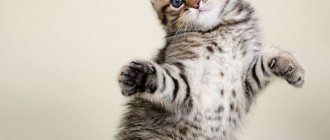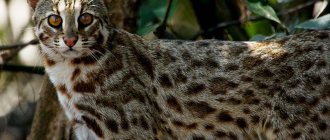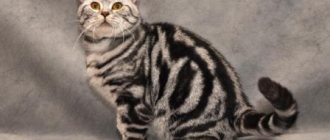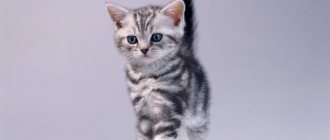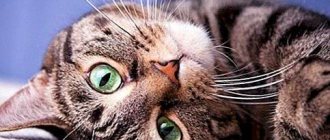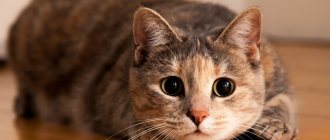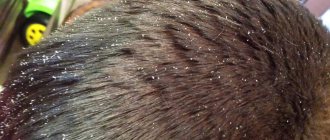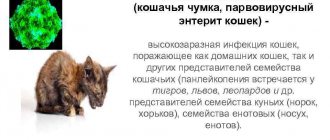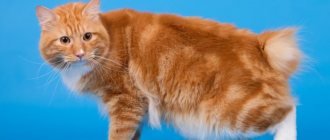What are they: description of colors
Due to the fruitful work of breeders, Bengal cats received a non-standard, rare color, similar to Leopard's. They constantly continue to work on improving the look. The most common color of this breed is tabby, and marbled is already exotic.
There are two types of basic wool background:
- Brown tabby. This includes all shades of gold, including yellow and orange.
- Silver tabby. This type includes gray-blue and silver shades.
The variety of Bengal patterns can be divided into 3 subspecies:
- Rosette. Dark border around the edges of light spots.
- Spotted. Evenly distributed dark spots over the body.
- Marble (Marble). Interesting beautiful dark patterns that differ in size and shape.
The standard pattern for Bengal cats is the following facial pattern:
- on the sides there are bright, dark stripes;
- on the forehead there is a pattern resembling the letter “M”;
- on the neck - a “necklace”;
Small spots, stripes or “decoration” resembling a butterfly are found on the shoulders. The pattern on the paws is spotted or striped.
The tip of the tail is always black; rosettes or rings may be located along its length. The belly, chest, chin, whisker pads and the inside of the paws are always lighter than the main background; spots may be present on the belly.
Breeders are doing everything possible to ensure that representatives of this cat breed are as similar as possible to leopards, but it has not yet been established which gene is responsible for coat color.
Unrecognized colors
In addition to the standard color of Bengals, there are new options that have not yet received recognition:
- Carbonic. The type resembles silver, but the base tone is much darker. The clearly defined black pattern has no blur and is clearly visible against a gray or ashy background. The general color palette is cold. The nose of the Charcoal Bengal is black, and there is a light edging around the eyes.
- Melanistic. The almost monochromatic black Bengal cat with a faintly visible pattern belongs to this color. A kitten is born with a normal contrasting pattern, which with age completely covers up the glitter. Occasionally, melanistic Bengals may be a different color.
- Blue. This color option is characterized by a less bright pattern of bluish-gray color with a metallic sheen. The pattern consists of large rosettes or spots. The background of the coat is bluish-gray on the back and soft peach on the belly. The Blue Bengal cat is extremely rare.
Types: stain or marble, rosettes on gold
Among cat lovers, red cats with a warm orange or golden hue are very popular.
They are characterized by:
- patterns are black, dark brown or chocolate, contrasting with the basic background;
- nose – brick red;
- The tip of the tail, the rim around the eyes and the pads of the paws are black;
- the eyes have shades of yellow and green.
For representatives of merle color:
- spots on the body in the form of complex horizontal stains of irregular shape;
- spots on the belly are required;
- There are three shades in the color: the base, the pattern and the edging of the patterns are dark.
Important!
If a marbled Bengal has spots with streaks that have a vague circular shape, the pet may be disqualified if it takes part in an exhibition.
The marbled color of such cats is unique, because it is almost impossible to repeat this pattern exactly. It is very difficult to breed such cats; in order for such a kitten to be born, parents of the appropriate colors are needed. Let's take a closer look at the features of each color.
White or snow leopards?
Snow color, which is recognized as the lightest, most spectacular and original, is divided into several types:
- Sepia. Recognized as the darkest of the snow colors. The background is golden, close to a light orange hue. The colors of the body and spots are indistinguishable. The paw pads and tip of the tail are dark brown. The eyes have a golden or yellow tint.
- Minx. The main background is a creamy, golden hue. Patterns on the body can be dark orange, light brown, contrasting with the main color. The tip of the ponytail is dark brown. Bright blue eye color.
- Links. The main color has shades of ivory and cream. The pattern on the body is predominantly marble, but rosettes and spots may occur. The paws, muzzle, tail and ears are much darker than the main background. Blue eyes.
Kittens of all three colors are born white or very light in color; as they grow older (not earlier than a year), the pattern becomes much clearer.
Reference!
Minx and sepia are difficult to distinguish visually, and genetic testing may be required to know the exact color type.
There are also Bengals with silver fur. In this case, the main color is white-silver or light. The pattern can be anything, like spots and rosettes, or silver marble, which contrasts with the base color.
Eyes, lips and nose - with black edging. The base background should be darker than the inside of the paws, belly, and the back should be darkened. The nose can be pink, red or brick colored. Eyes - from deep green to golden.
Phasing in kittens
Typically, small Bengals can be taken from the nursery at 2.5-3 months. But at this age, babies still do not have a clear pattern, there is a blurring of patterns, so people often doubt whether they are being given a purebred Bengal cat, especially for a lot of money.
When breeders start telling new owners about phasing, it doesn’t explain much to them.
So, phasing is a method of camouflage that hides the natural pattern of a kitten. This begins at the age of 1 month, with each month the coat becomes clearer, and by 7-8 months the Bengal becomes ideal, exactly what the owners dreamed of when they took the kitten from the nursery.
Knowing about phasing in kittens, there should be no doubt about the purebred kitten. You need to understand that the kitten will definitely not look like a leopard, but rather like a hedgehog.
It is important to know!
In some kittens, phasing is more pronounced, in others it is less pronounced. The lighter the kitten's background and the shorter its fur, the less susceptible it will be to phasing.
Features of the Bengal cat breed
Agile and dexterous Bengals love to play, run, if they want to sleep, then hide, and especially climb to heights, windowsills, closets, and the back of the sofa.
You need to talk to them more often, explain something, they really love to listen. It is worth considering that their genes contain an exotic instinct of a predator, so you should always accustom them to your hands and pet them often. But their habits and manner of play in no way mean that there is a predatory animal at home. On the contrary, these animals are very friendly.
This is just how they play, they need to spend a lot of energy, catch a bow, a ball, a twig, because Bengals are excellent hunters. By the way, representatives of this breed get along well with other cats.
Melanistic
The melanistic or black Bengal cat has black patterns on a black background, reminiscent of a black panther (the melanistic color variant of the jaguar or leopard).
Despite the fact that the pattern and basic background of such Bengals are black, in daylight you will be able to notice the pattern and understand that this is a Bengal and not some other breed.
The Black Bengal is a very rare breed. Since associations do not approve of this color, it is also not popular among breeders.
Reference!
The spots on these Bengals can range from dark brown to black.
Bengal cat breed
The story began in the USA, where young Jean Mill underwent a biological-genetic internship in the selection of cats. Then Jean successfully coped, but did not want to stop there. She began studying unusual cats and really wanted to breed an amazing breed. After many years of trying, she managed to find out that some predatory cats are immune to a virus called Leukemia, which is necessary for domestic cats.
And then the real scientific work on breeding the “Bengal breed” began. Jean found an amazing kitten in one of the zoos with golden fur and bright brown spots, but he had no tail, he was injured by a rhinoceros, and had to be amputated, but this did not stop him from becoming Deli (that’s what Jean called him).”
Little fidgets were born with incredibly stunning colors and brightly shiny fur. They grew large with a longer body structure and wide, elongated ears than ordinary cats. The eyes of "Bengal cats" are quite large and round, light.
Blue Bengal?
The Bengal blue cat is a stunning representative of the breed, the color of which looks great. This is a very rare species, but officially recognized.
The base background is blue-gray. The belly and chest have a slight peach tint. The pattern on the wool is grey, dark grey.
Métis
Felinological organizations prohibit crossing Bengals with other cat breeds. Because of this, there are no mixed-breed Bengal cats that are officially recognized. However, this does not prevent some irresponsible owners from mixing their purebred pet with other breeds. Usually these kittens are sold online or secondhand, but they are not considered Bengals. They will have a different size and color. The second generation from mestizos will be even less like a real Bengal.
But lately, the long-haired Bengal has become increasingly popular. While maintaining all the characteristics characteristic of a Bengal cat, they still have long hair, a fluffy collar and tail.
Reference!
Previously, in order not to spoil the purebred of the breed, such kittens were sterilized; now the long-haired Bengal is valued more than the traditional representative.
Shedding and wool allergies
The Bengal sheds in spring and autumn. Short hair falls off in separate hairs and remains on furniture and carpet without combing. If intense hair loss (as during molting) persists throughout the year, then it is necessary to adjust the animal’s nutrition.
Be sure to read:
How to choose a kitten that looks like a leopard - Bengal breed: photo, price, description?
Allergies to Bengal fur can occur. Only hairless cats do not cause this unpleasant phenomenon. In those that have wool, scales from the hairs spread into the air.
Beautiful Bengal cats are unusual pets
When you breathe, they get on the nasal mucosa and provoke allergies.
